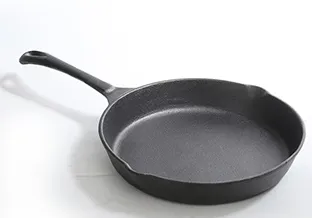
(2)Physical property:
The cast iron skillet has long been a staple in kitchens around the world. Renowned for its durability, heat retention, and versatility, this kitchen tool is cherished by both professional chefs and home cooks alike. Its ability to transition from stovetop to oven without missing a beat makes it a unique addition to any culinary arsenal.
Furthermore, regular seasoning is essential for maintaining the skillet's condition. Cooking with oil or fat ensures that the skillet retains its non-stick qualities, while also adding to its flavor profile. Each meal cooked in a cast iron skillet becomes imbued with the memories of previous dishes, enriching the taste and experience over time.
One of the standout features of a Dutch oven is its ability to distribute heat evenly. Crafted typically from cast iron, these pots offer excellent heat retention, allowing for steady cooking temperatures. This quality is particularly beneficial for slow-cooked dishes such as braises or casseroles, where the gentle heat coax flavors out of ingredients over time. The heavy lid seals in steam, preventing moisture loss and enhancing the dish's flavor profile. Imagine a rich beef stew bubbling away, the robust aromas wafting through your kitchen, all thanks to the magic of the Dutch oven.

Cooking in cast iron can enhance the flavor of your food. Over time, cast iron develops a natural non-stick seasoning, which can infuse dishes with a unique richness that is hard to replicate with other materials. The ability to cook at high temperatures without fear of damaging the surface allows for better caramelization and browning, leading to satisfying taste experiences that elevate your dishes.
Beyond its practical advantages, a cast iron Dutch oven also carries a certain rustic charm. Its timeless design and classic aesthetic appeal can transform any kitchen into a warm and inviting space. A well-seasoned Dutch oven often develops a natural non-stick surface, enhancing its appeal as it ages and improves with use.
In the world of culinary delights, the tools we use can significantly influence the experience of cooking and the final results on our plates. One of the most celebrated options among professional chefs and home cooks alike is enameled cast iron cookware. Not only is it known for its aesthetic appeal, but it also shines in functionality, making it a popular choice for various cooking methods. With the increasing demand for quality cookware, sales of enameled cast iron have surged, offering enthusiasts an opportunity to invest in this timeless kitchen staple.
When it comes to outdoor cooking, few tools are as versatile and reliable as a cast iron skillet. Perfectly suited for campfire cooking, this sturdy piece of cookware has been a favorite among campers, hikers, and outdoor enthusiasts for generations. Its durability, heat retention, and ability to handle a variety of cooking techniques make it an essential item for any camping trip.

(2)Physical property:
Solubility: HPMC is practically insoluble in absolute ethanol, ether, and acetone. HPMC is soluble in cold water and insoluble in hot water. HPMC will get gel when the temperature is up to 55-75. Hydroxypropyl methylcellulose after gelation is like jelly. This gel is related to methoxy content.
The benefits of incorporating HPMC into pharmaceutical formulations are manifold. By utilizing HPMC as a matrix former in sustained-release dosage forms, pharmaceutical manufacturers can achieve precise control over drug release, leading to optimized therapeutic outcomes and minimized side effects. Furthermore, HPMC’s bioadhesive properties make it suitable for use in ophthalmic formulations, enhancing the contact time of drugs with ocular tissues and improving the efficacy of treatments for conditions such as glaucoma and dry eye syndrome. Additionally, HPMC’s compatibility with a variety of active pharmaceutical ingredients and its ability to enhance solubility and bioavailability further contribute to its value in pharmaceutical applications, making it a preferred choice for formulators seeking to develop safe, effective, and patient-friendly drug products.
3)Temperature variations significantly affect the water retention of Methyl Cellulose. Generally, higher temperatures result in poorer water retention. If the temperature of the mortar exceeds 40℃, the water retention of Methyl Cellulose deteriorates, adversely affecting the workability of the mortar.
Discoloration temperature: 190-200 ℃